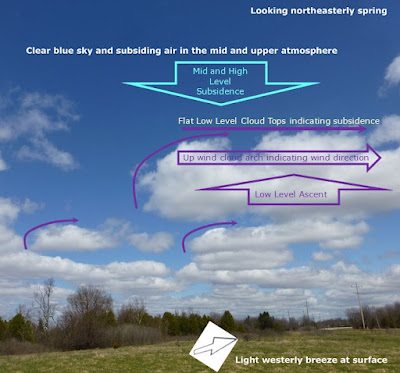Tom’s motivation to “record” this particular observation – the cloud structures combined with the colour of old snow and the rich sunset hues. Tom did love to paint sunsets!
This is certainly a sky filled with streets of stratocumulus aligned along northwesterly winds. This implies a thoroughly mixed planetary boundary layer and thus low-level instability during midday. The northwesterly winds were certainly stronger earlier in the afternoon but with the setting sun and the associated increasing stability, the winds must be diminishing making this plein air painting experience very enjoyable indeed. Plus, there were certainly no biting insects to mix into those oils.
Creative Scene Investigation (CSI) - What we know.
Timing: The shadows are the sundial for any plein air art timing. The word “Afternoon” is a generous gift from the title. Late afternoon can be determined from the colour of the illumination and Rayleigh scattering which removes the blue light from the spectrum of the direct beam originating from the sun. Only the longer wavelength red and orange hues are left in the direct beam from the setting sun to brighten the scene.
Direction of view: From the late afternoon timing and winter season, the shadows indicate that Tom was looking easterly to southeasterly with the shadows pointing like a sundial to the northeast.
Weather Situation: A high-pressure ridge was building in, causing subsidence in the air mass and a flattening of the turbulent stratocumulus cloud tops in the distance. Meteorologists refer to this common cloud top flattening as a “subsidence inversion”. As dry air sinks adiabatically (constant total energy within the parcel of air), the air parcels warm faster than the moist air thus creating a clear lid to the existing cloud. When a parcel of moist air subsides, some of the warming is offset by evapourative cooling as some water droplets transform into water vapour (Consult the Ideal Gas Law PV=nRT). In any event, the surface pressure was rising and the air was getting cooler.
Weather forecast: The skies would continue to clear and the
surface winds would diminish to calm after sunset. Continued subsidence would cause the
cloud tops to sink right through the cloud bases - poof, the cloud would vanish! The amount of cloud cover would also diminish with the
winds since turbulent mixing was evidently required to raise the surface air
parcels to their lifted condensation level. Aside from any upslope areas, it would
be absolutely clear overnight with all of the stars visible. Cloud waves perpendicular
to the northwesterly winds aloft could develop at the top of any upslope area where clouds might persist within the developing nocturnal inversion. Temperatures would be colder
than they were
The next day would be mainly sunny and dry with the high-pressure area. The surface winds would be light. The snow would not
melt even if the temperature climbed above freezing due to the dryness of the
air mass in the ridge. Any snow that does sublimate directly into water vapour
must take heat energy from the snowpack in order to escape as a gas. The sublimation
of snow in a dry air mass cools the snowpack and quickly eliminates any
sublimation. Surprisingly, snow does not melt when the air is dry.
 |
| Slide from Tom Thomson Was A Weatherman |
Tom would have been on the north side of the upper jet stream in
the area of northwesterly winds and turbulent stratocumulus.
 |
| A spring-time image of a very similar weather situation revealing that Tom observed and painted real clouds and everyday weather situations. |
Notice there is little chance of Tom’s shadow being in the painting and it certainly is not in this sketch even if it might have surfaced in his studio version - more of this in the next post.
Tom did not sign or name this painting as was his custom for his plein air weather observations. This sketch belonged to Tom's close friend and future Group of Seven artist, Franklin Carmichael. Fellow artists often swap work. The sketch passed to Franklin's daughter Ada and then to Mary Mastin of Toronto in 1945. This weather observation was eventually gifted to the McMichael Canadian Art Collection in Kleinburg by Mr. and Mrs. R.G. Mastin of Toronto in 1980.
I have been nose-to-nose with this sketch many times. In fact, I spent a lot of time at The McMichael when we lived at Watershed Farm on the 12th Concession of King Township. I was the "McMichael Artist in Residence" on September 30th, 2007 when I painted like Tom Thomson and encountered Emily Carr. It was a fictional meeting that never occurred in real life but lots of fun nonetheless.






No comments:
Post a Comment